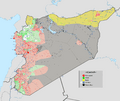Rojava facts for kids
Quick facts for kids
Rojava
|
|
|---|---|

Areas under the region's administration
|
|
| Status | De facto autonomous region of Syria |
| Capital | Ayn Issa 36°23′7″N 38°51′34″E / 36.38528°N 38.85944°E |
| Largest city | Raqqa |
| Official languages | See languages |
| Government | Libertarian socialist federated semi-direct democracy |
|
• Co-Presidents
|
Îlham Ehmed Mansur Selum |
|
• Co-Chairs
|
Amina Omar Riad Darar |
| Legislature | Syrian Democratic Council |
| Autonomous region | |
|
• Transitional administration declared
|
2013 |
|
• Cantons declare autonomy
|
January 2014 |
|
• Cantons declare federation
|
17 March 2016 |
|
• New administration declared
|
6 September 2018 |
| Area | |
|
• Total
|
50,000 km2 (19,000 sq mi) |
| Population | |
|
• 2018 estimate
|
≈2,000,000 |
| Currency | Syrian pound (SYP) |
| Time zone | UTC+2 (EET) |
| Driving side | right |
The Autonomous Administration of North and East Syria (NES) is also known as Rojava. It is a special area in northeastern Syria that governs itself. This means it acts like an independent region, even though other countries don't officially recognize it as a separate country.
The NES is made up of several self-governing areas. These include Afrin, Jazira, Euphrates, Raqqa, Tabqa, Manbij, and Deir Ez-Zor. The region started governing itself in 2012 during the Syrian Civil War. Its military, called the Syrian Democratic Forces (SDF), has been involved in the conflict.
Even though the NES has some relationships with other countries, no country or international group officially says it is an independent region. Many different groups of people live in northeastern Syria. The largest groups are Kurdish, Arab, and Assyrian people. There are also smaller groups like Turkmen, Armenians, and Circassians.
Contents
History of Rojava
How Rojava Started
The Autonomous Administration of North and East Syria began to govern itself during the Syrian Civil War. This war started in 2011. As the Syrian government focused on other parts of the country, local groups in the northeast took control of their areas.
In 2012, these groups, mainly Kurdish, started to set up their own government. They wanted to create a system where local communities had more power.
Forming the Administration
In January 2014, the different areas in Rojava declared themselves "cantons." A canton is like a small, self-governing region. These cantons worked together to form a larger administration.
Later, in March 2016, these cantons decided to create a federation. A federation is a group of states or regions that join together but keep some of their own power. This was a step towards a more organized self-governing system.
In September 2018, a new administration was officially announced. This helped to bring all the self-governing areas under one system.
People and Culture
Diverse Communities
North and East Syria is home to many different groups of people. The main groups are Kurds, Arabs, and Assyrians. Each group has its own language, traditions, and culture.
- Kurds: The Kurdish people are a large group in the region. They have a rich history and culture, and their language is Kurdish.
- Arabs: Arab people also make up a big part of the population. They speak Arabic and have their own cultural traditions.
- Assyrians: Assyrians are an ancient group of people who have lived in this region for thousands of years. They speak Syriac-Aramaic.
There are also smaller communities of Turkmen, Armenians, and Circassians. This mix of cultures makes the region very unique.
Languages Spoken
The official languages in North and East Syria are Kurdish, Arabic, and Syriac-Aramaic. This shows how important it is for all the different groups to be able to communicate and keep their languages alive.
Daily Life and Education
Life in Rojava involves people working together to build their communities. The administration supports local efforts, like helping workers form cooperatives. A cooperative is a business or organization owned and run by its members.
Education is also important. Schools teach children about their culture and help them learn new skills, including music and arts.
Geography and Environment
Rivers and Mountains
The region is known for its important rivers, like the Khabur river. Rivers are vital for farming and providing water.
There are also mountains, such as Sharat Kovakab, which is a volcano near the city of Al-Hasakah.
Ancient History
North and East Syria has a very long history. It was part of the Fertile Crescent, which is an area in the Middle East where some of the earliest civilizations began. Because of this, there are many ancient sites, like Tell Halaf, where people can learn about the past.
Images for kids
-
Having been part of the Fertile Crescent, Northern Syria has several Neolithic sites such as Tell Halaf.
-
The Ba'athist government of Syria under Hafez al-Assad (pictured c. 1987) implemented Arabization policies in northern Syria.
-
Children in (AANES) school curriculum children learning to play instruments and arts
-
Border crossing at Semalka between Iraqi Kurdistan government and the AANES on the Tigris river.
-
SDF Yazidis praying in a Yazidi temple, with a mural of the holy Melek Taus, in AANES (Rojava) following the expulsion of ISIS
-
A YPJ soldier next to a large reservoir in Northern Syria
-
Salih Muslim, co-chairman of the region's leading Democratic Union Party (PYD) with Ulla Jelpke at Rosa Luxemburg Foundation in Berlin
See also
 In Spanish: Rojava para niños
In Spanish: Rojava para niños































